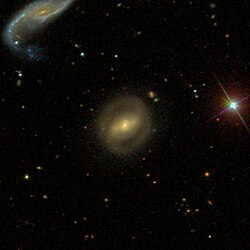| NGC 4614 | |
|---|---|
 SDSS image of NGC 4614 | |
| Observation data (J2000 epoch) | |
| Constellation | Coma Berenices |
| Right ascension | 12h 41m 31.46397s [1] |
| Declination | +26° 02′ 33.6235″ [1] |
| Redshift | 0.01594 [2] |
| Heliocentric radial velocity | 4741 km/s [2] |
| Distance | 234.9 Mly (72.03 Mpc) [3] |
| Apparent magnitude (B) | 14.2 [2] |
| Characteristics | |
| Type | SB0/a [4] |
| Other designations | |
| UGC 7851, MCG +04-30-012, PGC 42573 [2] | |
NGC 4614 is a barred lenticular galaxy in the New General Catalog. It is located in the constellation of Coma Berenices. It was discovered on 9 May 1864 by German astronomer Heinrich d'Arrest, with a 11.9 inch (11 inch) diameter lens type telescope. [5]
One supernova has been observed in NGC 4614: SN 2018ata (Type Ia, mag. 20.1) was discovered by Mirco Villi and the Catalina Real-time Transient Survey on 10 April 2018. [6]